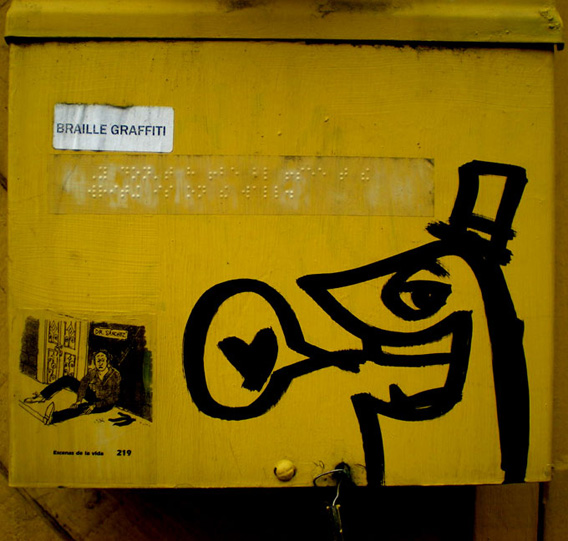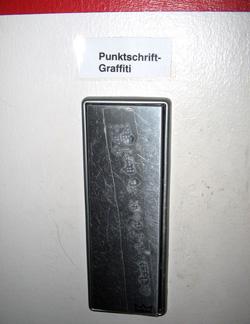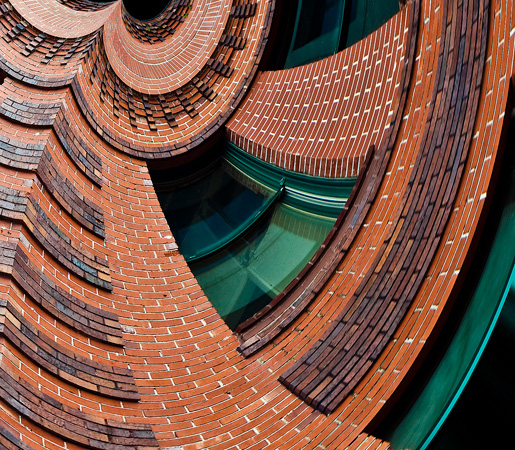Oh Snap!: Celebrating World Braille Day with Bumpy Graffiti and a Blind Photographer
Today is World Braille Day, a good excuse to celebrate visual art created by and for the visually impaired.
Graffiti is something many of us, especially in cities, come to take for granted. We see it so often that only the really inventive sort surprises us. But why should sight be required for that kind of spontaneous discovery? This is the question that drove Scott Wayne Indiana to place Braille graffiti throughout Portland in August 2007.

An experimental, community-minded artist, Indiana says he hoped that by carefully documenting his process others might replicate his work. A few months ago, he got his reward: Students at a school in Soest, Germany e-mailed him to say his project had inspired them to create something similar around their campus. He shared their Braille graffiti creations with me, along with their translations. “Augenlicht besitzt du nicht, und trotzdem hast du ein Gesicht” roughly translates as “You've got no eyesight, but your face is all right”; “Du siehst die Welt mit anderen Augen” means “You see the world in a different light.”

Is there any artistic pursuit more seemingly closed off to the blind than graffiti? How about photography? Although there are occasionally exhibits of photography by visually impaired artists, it's still rare to encounter work by a blind photographer alongside the efforts of his sighted peers. That’s why it was especially refreshing to discover that Craig Royal won Best of Show at the Florida Museum of Photographic Arts annual members’ show this year. (You can see his award-winning work in this slide show.)
Were other contestants surprised to find out he is visually impaired?
“No, no one really said anything about that,” he told me over the phone, explaining that perhaps most simply didn’t know.
Craig has been legally blind since birth, due to a congenital form of optic atrophy. In 1992, a blind white spot developed in both eyes, meaning that if someone stands about four feet in front of him, his or her head disappears.
He explained his condition in an interview with a website for blind photographers:
“My peripheral vision is blurred so I miss out on a lot of detail and [everything] has an impressionist quality about it. The white blind spot adds a surreal element.”
Woodworking used to be his creative outlet, but as his sight worsened, it got too frustrating, he told me. About four years ago, he turned to photography. With the camera as his eye, the visual world became exciting again. After some experimentation, he developed a fascination with photographing water using auto-focus and a very slow shutter speed.
He uncovers what he’s captured when back in the editing room, where he uses a 4x telescope—similar to what surgeons use while operating—to navigate Photoshop, manipulating forms that intrigue him. The results are abstract creations that play with shapes and color; only small details offering hints that they emerged from the natural world. The images feel less like photographs than paintings or light drawings. Similarly, his architectural photographs have a surreal quality; colors are saturated to the extreme and lines become twisted. For some, the aesthetic may seem overly artificial, but that’s precisely what makes them conceptually interesting. How does one talk about photographic realism when the photographer in question see things differently than the rest of us?
Oh Snap! is Brow Beat’s weekly photo feature. Have you spotted a project that’s worth profiling? Pitch to ohsnapidea@gmail.com.


